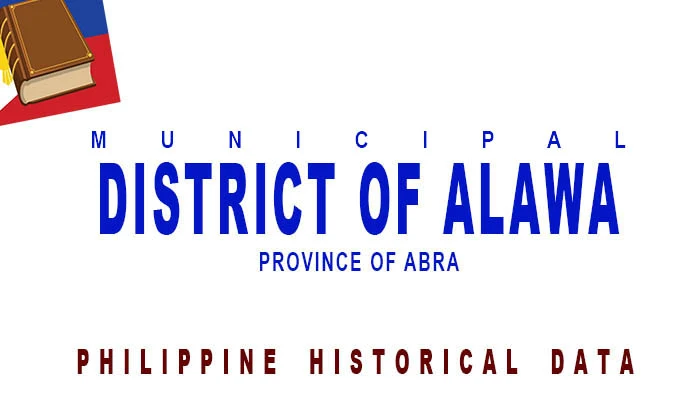MUNICIPAL DISTRICT OF ALAWA, Historical Data
[Title page.]
HISTORICAL DATA
of the
Municipal District of
A L A W A,
PROVINCE OF ABRA
[Foreword]
FOREWORD
This report is the product of the joint efforts of a committee composed of Miss Irene Taza, Chairman, and Mr. Benedicto Perlas, member, both public school teachers of the Municipal District of Alawa, Province of Abra.
The information herein set forth was gathered from old people who are natives of Alawa. No written records were consulted.
Principal-in-Charge
Licuan District
[p. 1]
HISTORY AND CULTURAL LIFE OF THE
MUNICIPAL DISTRICT OF ALAWA
PROVINCE OF ABRA
THE MUNICIPAL DISTRICT OF ALAWA
Long ago there were two travelers who were seeking a place for them to stay. When they reached the top of a mountain, they saw a valley. Upon reaching the place, they found out that it was a spacious place. So, the people called the place "Nalawa," meaning spacious. From this word the name Alawa was derived.
The former name of this place was Ulmedan, which was derived from the name of a native pagan of the town. The establishment of this place as a municipal district was in the year 1918, although it had already been settled during the Spanish time.
FOUNDERS OFFICIALS
The founders were Mangad, Ugan, [and] Quiagay, all farmers. Those who held leading official positions in the community during the Spanish time were Don Juan Villamor, as the Gobernadorsillo; Capitan Mangad as the Capitan Municipal; Culeb, as the Teniente Absoluto; Padre Paulino as the Cura Parroco; Timoteo Crisologo as the Juez de Sementra - y de Policia; and Lupe Tamonte as the Maestro Municipal.
When the Americans arrived, among those still remembered by the people were President Cammagay, Vice President Leyad, Mayor Mangad, Vice Mayor Ulingan, Councilor Sagibo, Municipal Treasurer Fiorentino Buenafe, and Policeman Ayao.
SPANISH OCCUPATION
AMERICAN OCCUPATION
WORLD WAR II
On December 8, 1941 the war broke out and school was closed. Classes were resumed by the Japanese Government in 1942-43.
The economic condition of the town was very poor. Cultivation of land not extensive. Some properties of the rich people such as blankets, shoes and clothes were taken by the cruel invaders. Two men were killed by the Japanese. The School of Alawa was burned.
[p. 2]
FOLKWAYS
The natives of Alawa still follow the traditions of their ancestors. The men wear G-Strings or the "Baag." The women wear the "ikken" (tapis) and cuba (G-string for women). The women's arms are tattooed.
After a woman has given birth, she goes out immediately. No elaborate post delivery treatments are made.
When a girl was born and a boy was also born, the parents of the children made a contract which they called "Tampa," that the children would be married. During the wedding party, the people butcher a cow or a carabao for the visitors. They dance a native dance, called "Tadec." A jar of Basi is placed in the middle of the house for everyone. When someone dies, they make the dead person sit on a chair as long as one week. They bury their dead under the house. The members of the family of the dead person cannot take a bath for three months.
When there are visitors, they dress up in red clothing which they call Kirit. They wear beads called batec. When they go to another place, they wear distinctive costumes called "Sagayab" and "Srayon."
Their common songs are called "Diwas" and "Salidommay."
EXAMPLE SALIDOMMAY
Ay, ay salidom-may salidom-may di-ay
DANG-DANGAY
1. Danddang-ay i-dong HayCacapitan, Cacapitanas,
Agraman icen dodonias,
Insalidommay di-was
PROVERBS
He who plants will reap.
MEASURING TIME
The people of the town use their shadows for measuring time, and the crowing of the cocks also aid them in telling time.
A person who commits a sin is fined one jar of "basi" or pig depending upon the gravity of the offense.
Some of their recreations are playing the Calaling and Coliteng. The Calaleng is made of bamboo which is played with the nose or the mouth. The Coliteng is made also with bamboo. It is like a guitar and is played like one.
[p. 3]
NAMES FOR THE MONTHS OF THE YEAR
|
1. 2. 3. 4. 5. 6. |
January February March April May June |
- - - - - - |
Bacacao Bitbit Manaba Adaway Abal Kamadoyong |
7. 8. 9. 10. 11. 12. |
July August September October November December |
- - - - - - |
Walo Bisbis Luya Kiling Butbut Laudao |
FOLKTALES
(Teacher-in-Charge)

